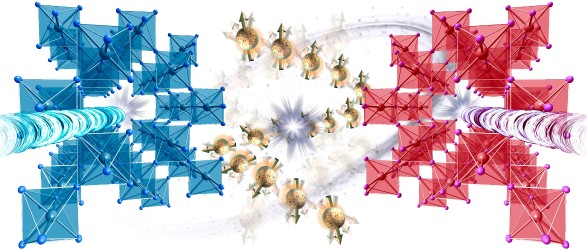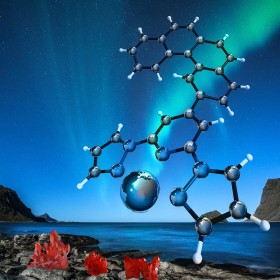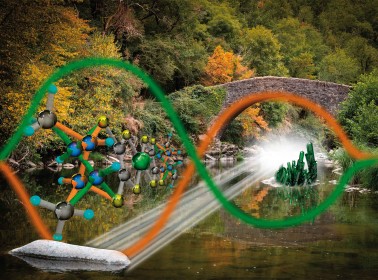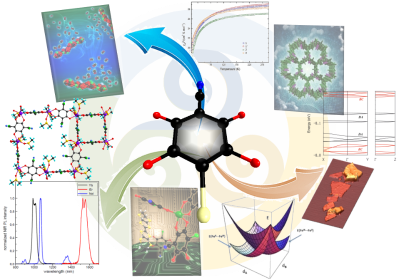- >Accès directs
- >Annuaire
- >A
- >B
- >a.abh

Alexandre AbherveChimie - UMR CNRS - MOLTECH ANJOU
- Structure Fédérative de Recherche Matériaux : SFR MATRIX
- Structure Fédérative de Recherche Matériaux : SFR MATRIX - Moltech ANJOU
Chimie - UMR CNRS - MOLTECH ANJOU - 2 Boulevard de Lavoisier - 49045 - ANGERS CEDEX 01
- Chimie - UMR CNRS - MOLTECH ANJOU
- Courriel : alexandre.abherve @ univ-angers.fr
Discipline
Chemistry
Thèmes de recherche
Chiral Halide Perovskites
Synthesis of Chiral Halide Perovskites, structural characterization by single-crystal X-ray diffraction, and characterization of their optical and electronic properties.

Chiral Halide Perovskites bring new perspectives for chiroptical applications, such as circularly polarized luminescence (CPL), and spintronic applications. By combining the optoelectronic properties of HP networks with chirality transfer from inserted organic cations, we aim to reveal the potential of chiral halide perovskite materials for CPL and chiro-spintronics. For example, the emergent field of chiro-spintronics proposes to use chiral molecules as a substitute for ferromagnetic materials thanks to the spin-specific interaction between electrons and chiral molecules, a phenomenon called CISS, “chiral-induced spin selectivity”. Chiral HPs are promising candidates in the field thanks to their strong CISS effect. Finally, their strong luminescence makes them candidates for the preparation CP-PeLEDs, devices using a chiral halide perovskite material to produce a circularly polarized electroluminescence.
Circularly Polarized Luminescence of Coordination Complexes
Synthesis of chiral N-donor ligands and coordination complexes with transition metal ions or lanthanides, characterization of their chiroptical properties.

Attachment of coordinating groups on the helicene platform results in helicene based ligands and corresponding transition metal complexes or lanthanide complexes. We mainly study these compounds for the emission of circularly polarized light (CPL). Synthesis of enantiopure helicene-based bis(pyrazol-1-yl)pyridine ligands (1-bpp) allowed us to prepare chiral Eu(III) complexes with CPL in the visible region. We recently extended our research to other chiral 1-bpp derivatives in the quest of strongly emissive complexes with high dissymmetry factors.
Chiral Conductors based on Metal-bis(dithiolene) Complexes
Synthesis of metal-bis(dithiolene) complexes, structural characterization by single-crystal X-ray diffraction, characterization of their chiroptical and conducting properties.

Metal-bis(dithiolene) complexes are an important family of molecular conductors since they usually have a small HOMO-LUMO energy gap and can thus present a metallic band structure under pressure. We designed a series of nickel-bis(dithiolene) complexes based on the chiral dithiolene ligands and performed resistivity measurements under very high pressure using a diamond anvil cell (DAC). We showed that the use of chiral dithiolene ligands with one or two stereogenic centres, together with variation of the counter-ion in the anionic complexes, represents a powerful strategy to modulate the conducting properties of such molecular materials.
Anilate-based Coordination Polymers
Crystallization and structural characterization by single-crystal X-ray diffraction of anilate-based coordination polymers, characterization of their magnetic, conducting and luminescent properties.

We investigate the use of the chlorocyananilate (ClCNAn2-) anion for the preparation of luminescent/magnetic coordination polymers (CPs) based on transition metal ions or lanthanides. The mixed-valence FeIIFeIII 2D coordination polymer shows both magnetic ordering and semiconducting behavior. A small-polaron hopping model has been applied to a series of oxalate-type FeIIFeIII 2D coordination polymers, providing a clear explanation on the much higher conductivity of the anilate-based systems than the oxalate ones. On the other hand, in the series of CPs with lanthanides, we have demonstrated that the ClCNAn2- bridging ligand acts as an efficient antenna for the luminescence of the lanthanide metal centre in the NIR region. After exfoliation of these 2D networks into nanosheets, we observed that the emission properties were preserved at the nanoscale level. Following these results, we prepared two heteroleptic YbIII CPs, constructed from ClCNAn2- and derivatives of benzene-1,4-dicarboxylate (terephthalate) organic linkers. The resulting 2D networks of formula [Yb4(ClCNAn)5(DOBDC)(DMSO)10] and [Yb2(ClCNAn)2(F4-BDC)(DMSO)6] showed similar NIR-emission of the YbIII ion at both bulk and nanoscale levels. Deeper photophysical studies revealed that the emission could be quenched upon exposure to nitrobenzene, showing the ability of these materials to act as solvent sensors.
CV
2015 PhD in Chemistry, “Hybrid Magnetic Materials based on Coordination Chemistry: From Switching Magnetic Molecules to 2D Coordination Polymers”, Instituto de Ciencia Molecular, Universidad de Valencia, Spain.
2013 Master’s degree “Molecular Nanoscience and Nanotechnology”, Instituto de Ciencia Molecular, Universidad de Valencia, Spain.
2011 Master’s degree “Molecular Chemistry and Electrochemistry, Analytical Chemistry”, Département de Chimie, Université de Bretagne Occidentale, France.
Publications
Co-author of 27 scientific publications (15 as first author, 18 without PhD supervisors, 5 as corresponding author, 1 review, h-index: 14) in high-impact peer-reviewed international journals, including: Inorg. Chem. (8), Dalton Trans. (3), J. Mater. Chem. C (2), Cryst. Growth Des. (2), Eur. J. Inorg. Chem. (2), J. Am. Chem. Soc. (1), Chem. Sci. (1), ACS Appl. Mater. Interfaces (1), Chem. Mater. (1), Chem. Commun. (1), ACS Appl. Nano Mater. (1), New J. Chem. (1), CrystEngComm (1), Crystals (1), Chirality (1).
|
|


